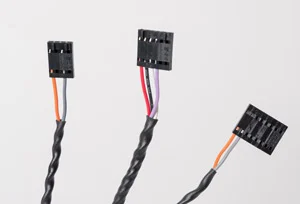Wire harness connectors and terminals are basic components found in a wire harness. A wire harness, sometimes referred to as a wire assembly, is a set of multiple wires or cables in their own protective covers or jackets that are bundled into a single wire harness. Wire harnesses keep electronic or electrical systems organized to transmit signals, relay information, or electrical power. They also protect the bound wires from constant friction, general wear, temperature extremes and other environmental conditions or potential damage that the harness may be exposed to.
Though wire harness design may vary greatly depending on the application or system requirements, the three fundamental components of a wire harness are the same. A wiring harness consists of wires, connectors and terminals. The latter two are the backbone of the wire harness. The types of connectors and terminals used in a wire harness directly determine the overall performance, reliability and stability of the harness.
Wire Harness Connectors
 Connectors are the electro-mechanical devices used to form a continuous electronic signal to connect wire harnesses to a power source or circuit. On a basic level, connectors consist of male-ended plugs and female-ended jacks that can be joined together to relay an electronic signal. They are the familiar mating pair of polarized multi-pin connectors with wire leads. A male-ended plastic housing with release fits into a snap-mounted female-ended chassis mounting. The pair can be connected or disconnected easily and come in a variety of sizes, shapes, materials, quality, and dimensions—circular, header, pin, crimped, multitap—which are dependent on the application.
Connectors are the electro-mechanical devices used to form a continuous electronic signal to connect wire harnesses to a power source or circuit. On a basic level, connectors consist of male-ended plugs and female-ended jacks that can be joined together to relay an electronic signal. They are the familiar mating pair of polarized multi-pin connectors with wire leads. A male-ended plastic housing with release fits into a snap-mounted female-ended chassis mounting. The pair can be connected or disconnected easily and come in a variety of sizes, shapes, materials, quality, and dimensions—circular, header, pin, crimped, multitap—which are dependent on the application.
Connector Types
The design features of connectors are related to their performance. Their function dictates design. The ease of connection, the particular mating type, durability, the necessary insulation between pins and so on, is determined by the environment that the connectors will perform in. This includes protection from extreme temperatures, constant vibration, moisture, contaminants, dust, dirt, and the like.
Because connectors must perform many functions under many conditions, their design varies widely for a broad range of applications, from consumer electronics to powering aerospace, medical equipment and military hardware. Their only commonality is that they provide an inline connect and disconnect within a circuit. The shapes and sizes of the connectors are designed to fit the needs.
Choosing the Right Wire Harness Connectors
Connectors consist of a number of signal contacts, a number of power contacts, and configurations such as board-to-board, wire-to-wire, or board-to-wire. Manufacturing of connectors produces an extensive catalog of standard designs such as 2, 3 and 4 pin connectors or similar conductor locking connectors, or weather resistant connectors. Depending on the needs, custom connectors can be manufactured to fit an application’s specifications.
Wire Harness Terminals
Terminals are another necessary component to establish an electronic or electrical connection in a wire harness. The terminal is an electromechanical device that terminates a conductor to a fixed post, stud, chassis, etc., to establish that connection. They are generally composed of a metal or alloy, but there are other conductive materials available such as carbon or silicon.
Terminal Types
Terminals come in many designs, shapes and sizes. They are the familiar pins in connector housings that provide electrical or electronic conduction to secure the connections. There are terminations used to join the connector pin or socket to its associated conductor – whether it’s a wire or PCB trace, for example. Terminal types vary, too. They may be crimped connections, soldered connections, press-fit in a ribbon connector or even wire-wrap. They also come in many shapes such as ring, spade, hook, quick-disconnect, bullet, butt terminals and flagged.
Choosing the Right Wire Harness Terminals
Terminal selection will depend on your design and application as a whole. For example, they can be insulated or non-insulated. Insulation provides a protective, non-conductive layer. In harsh environmental conditions, insulated terminals protect the device and components from moisture and temperature extremes. Insulation is typically made of either a thermoplastic or thermoset polymer wrap. If no protection from environmental conditions is required, non-insulated terminals are an economical choice.
Each wire harness application is unique and designed for a particular function, with its own set of constraints and combination of signals. The selection of the right connectors and terminals for the application is vital to the overall performance of the wire harness and its success.


